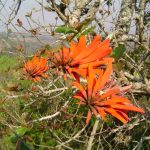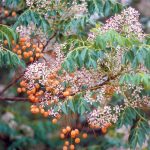TREE LIFE
JANUARY 2016
The Tree Society Committee wishes all members a very happy and healthy 2016.
MASHONALAND CALENDAR
Saturday 2nd January: Botanical Gardens walk with Tom Muller. Meet at 08.45 for a 09.00 start in the Car Park.
Sunday 17th January : Visit to Bushman Rock in the Goromonzi area, courtesy of Rick Passaportis. Rick has asked how many people to expect so if you would like to go, please give Mary a call on 0772 261 621. But don’t let this deter you from a last minute decision to join in. We will meet at the Mukuvisi Car Park at 08.30 for a prompt 08.45 departure. Directions are available for those wishing to go independently: We meet at 9.30.
Saturday 23rd January : Visit to Dave and Olwen Hartung’s garden in Mt Pleasant.
If it is pouring with rain Dave has offered to show us some of his magnificent photographs “From Ants to Elephants”. We meet at 14.30.
PLANTED TREES OF HARARE: Fraxinus excelsior, European Ash
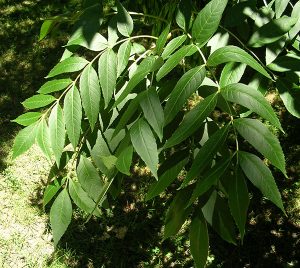
Fraxinus excelsior
Fraxinus excelsior — known as Ash, European Ash or Common Ash to distinguish it from other types of Ash — is a species native to most of Europe from Portugal to Russia, with the exception of northern Scandinavia to the southern Iberian peninsular. It is also considered native in south-western Asia, from northern Turkey east to the Caucasus and the Alborz mountains.
This is a large deciduous tree growing to 20- 35m (exceptionally to 46 m) with a trunk diameter of between 2-3.5 m and a tall, domed crown. The bark is smooth and pale grey on young trees, becoming thick and vertically fissured on old trees. The shoots are stout, greenish-grey, with jet-black buds (which distinguish it from most other Ash species, which have grey or brown buds). The leaves are 20–35 cm long, pinnately compound, with three to five pairs of leaflets, which can be 3–12 cm long and 0.8–3 cm wide. They are borne without stalk or peduncle (i.e. sessile) on the leaf rachis and with a serrated margin. The leaves are often among the last to open in spring and the first to fall in autumn if an early frost strikes; they have no marked autumn colour, often falling dull green.
Flowers are purplish to yellow to greenish, very small with no petals or sepals, in many-flowered clusters.
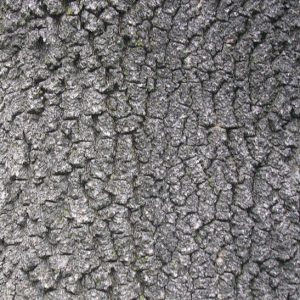
Fraxinus excelsior mature bark
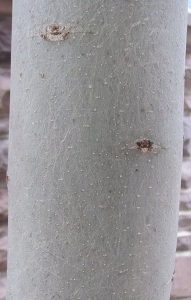
Fraxinus excelsior young bark
The flowers open before the leaves, the female flowers being somewhat longer than the male flowers; they are dark purple, without petals and are wind-pollinated. Both male and female flowers can occur on the same tree, but it is more common to find all male and all female trees. A tree that is all male one year can produce female flowers the next and similarly a female tree can become male. The fruit is a samara (a winged achene) usually 2.5–4.5 cm long and 5–8 mm broad, often hanging in bunches through the winter. They are often called ‘ash keys’. If the fruit is gathered and planted when it is still green and not fully ripe, it will germinate straight away. However once the fruit is brown and fully ripe, it will not germinate until 18 months after sowing (i.e. not until two winters have passed).
Young bark is smooth, mature bark is rough and vertically fissured.
European Ash rarely exceeds 250 years of age. However, there are numerous specimens estimated between 200 and 250 years old and there are a few over 250. The largest is at Clapton Court in Somerset in England and is 9m in girth.
Sources:
Tree Topics: Fraxinus excelsior https://www.treetopics.com/fraxinus_excelsior/index.htm
Wikipedia: Fraxinus excelsior https://en.wikipedia.org/wiki/Fraxinus_excelsior
The Tree Species Pages: European Ash. https://canadiantreetours.org/species-pages/European_ash.html
Tree Browser: Ash, European. https://www.treebrowser.org/index.cfm%3Fcontroller%3Dfinal%26action%3Ddetails%26key%3D7%26sortb
-Bilal Khatri
OUTING TO NEW YEAR’S GIFT, CHIPINGE (cont’d) SUNDAY, 8 NOVEMBER 2015
The best way to introduce Chirinda Forest at Mt Selinda is to quote from the excellent booklet “Chirinda Forest – A visitors guide” edited by Jonathan Timberlake. Chirinda Forest is described as the largest medium altitude rainforest in Zimbabwe, the most southerly of its type and having the greatest mix of East and southern African plants and animal species, some of which are endemic. There is a still hushed atmosphere generated by its well-buttressed giants – solid towering Chrysophyllum, Lovoa and Trichilia – strangling figs with chaotic, twisted, hollow stems and of course the Big Tree, Khaya anthotheca, reaching 65m in height and 4.5m around its base. This is a forest with a timeless quality that has been relatively unchanged for thousands of years. The altitude is 1000m with no high ground between it and the Indian Ocean and has a mean annual rainfall of 1400mm.
The difficulty with botanising in such a forest is that in most cases you cannot “pick a leaf” as Meg usually requests. Fortunately the major forest components are numbered and by using the booklet even the casual visitor can identify a tree. Much of the scientific wonder of the Chirinda was revealed by C.F.M Swynnerton, an outstanding naturalist who lived nearby for 20 years and who collected new species for the first time. He was awarded the C.M.G. (Order of St Michael and St George) in 1937, but died in an air crash in 1938.
Our group was fortunate to have the “Three Wise People” – Tom, Meg and Mark – to guide us through this botanical wonderland on a lovely warm day. Tom is the exponent of the “slash test” which he discreetly performed with my panga behind each tree, an important way to confirm identification of forest trees.
There are 3 layers of the forest – the Canopy trees, the Sub- canopy and the Shrub layer:
The Canopy Layer
The family Meliaceae is represented by three species, namely Khaya anthotheca (The Big Tree – Red Mahogany), Trichilia dregeana (Natal Forest Mahogany) – one of the commonest trees in the forest, a huge tree with pinnate leaves – and Lovoa swynnertonii (Miniature Wooden Banana) another huge tree with orange under-bark, pinnate leaves, stems more tapered and a bark which scales off in flakes.
The family Moraceae is represented by two species Ficus chirindensis (Fairytale Fig), the commonest of the gigantic strangler figs in the forest and Ficus scassellati (Crown Fruit Fig), whose smooth bark varies in colour from pale grey to dark brown.
There is one species of the Euphorbiaceae family namely Croton sylvaticus (Forest Croton) which Tom demonstrated is the only tree to be identifiable from the peppery smell of the slash. Newtonia buchananii (family Mimosoideae) is found mainly along the water courses and is common in the lower lying Eastern Districts forests.
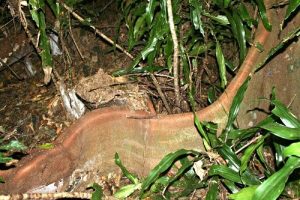
Craibia brevicaudata
Craibia brevicaudata of the Papilionaceae family is common, with a round, light green crown and showy pea-like flowers. It has sharp buttresses and a pale cream slice. The family Sapotaceae is represented by Chrysophyllum gorungosanum (Brown-berry Fluted Milkwood). It is one of the tallest trees, easily recognised from the rusty brown colour of the underleaves, milky latex and rounded buttresses that extend up high.
In the family Celtidaceae is Celtis gomphophylla (Rough leaved White Stinkwood) whose enormous, low buttresses extend many metres from the trunk. The boles are long and straight with a grey – green bark.
Strychnos mitis (Yellow Bitter Berry) is confined principally to the Chrinda Forest and is otherwise rare in Zimbabwe. This is a lofty tree with large, long fairly smooth trunk and exceptionally thin bark. The one-seeded fruits are relished by both birds and mammals.
Casearia battiscombei (Forest Sword Leaf, family Flacourtiaceae) has a long, clean almost white trunk and thin flaky bark, while Strombosia scheffleri (family Oleaceae) exceeds 30 metres in height and has smooth, dark brownish–grey bark flaking off in patches to give a piebald appearance.
Sub Canopy layer
These smaller trees receive lower light levels to which they adapt in different ways. The Euphorbiaceae are well represented by Tannodia swynnertonii which is common and wide spread but not seen elsewhere in Zimbabwe, Drypetes gerrardii (Forest Iron Plum) and Argomuellera macrophylla (Undershrub Big-leaf) with large leathery, toothed leaves. There are two Strychnos species: S. mellodora (Forest Monkey Orange, found only in Chirinda) with simple opposite leaves and not 3-veined but parallel veined; and S. usambarensis (Blue Bitter Berry).
Of interest is Celtis mildbraedii (Red Fruited White Stinkwood), last seen by members at Catapu, which is a well buttressed big tree that has waxy, bright scarlet fruits. Xymalos monospora (Lemonwood) is wide-spread in the Eastern Districts, as is Cassipourea malosana (Onionwood).
The Forest Rothmannia Rothmannia urcelliformis has attractive speckled, trumpet-shaped flowers, while the Smallfruit Toad Tree Tabernaemontana ventricosa has showy white fragrant flowers. The Fluted Milkwood Chrysophyllum viridifolium differs from its large relation in that it has more rounded buttresses at the base and the leaves are smaller, with parallel veins. A curiosity is Myrianthus holstii, with large palmate leaves and an edible fruit that resembles a hand grenade. Finally Senegalia pentagona, a woody creeper with vicious curved spines ready to trip you up.
Shrub layer
The shrub layer is dominated by Dracaena steudneri, the Northern Large-leaved Dragon Tree, a much-favoured habitat of the Swynnerton’s Robin. Mark identified a climber of the Arum family, namely Culcasia orientalis, which has two small berries on the stalk. Also pointed out by Mark was Leptaspis zeylonica, a grass which looks nothing like a grass and is very rare in Zimbabwe, with surprisingly broad leaves and a terminal shell-shaped inflorescence. The broad leaves must be an adaptation to low lights limits.
For anyone interested in flora, Chirinda is a special, almost spiritual experience, where one can only marvel at nature. After a good few hours trying to absorb it all from experts, we returned to the car park for a picnic lunch within the forest, along with the Chimanimani contingent of Dave and Irene Meikle and Doug and Tempe Van der Ruit who joined us for the day. Special thanks to Tom Muller whose understanding and explanation of the dynamics of a rain forest was so helpful.
MONDAY, 9 NOVEMBER 2015
On the last day it was agreed that we should return to the area that we had been looking at on the first day, so after an enormous breakfast, 12 members braved the heat which, at 9 am, was already stifling. We walked along a road that ran between a very rocky range and a watercourse. This year the rains had cut off early, the veld was extremely dry and most of the trees were without leaf, making identification extremely challenging. Along the watercourse however we were rewarded with not only leaves on the trees but also many trees in bud or full flower.
The semi-evergreen Euclea schimperi (River Guarri), found along river courses, was full of small creamy white flowers and nearby was the fairly common Dalbergia melanoxylon (Ebony Dalbergia) with its new leaves clustered along small spinescent branches. Rhoicissus revoilii (Warty Grape)’s leaves are extremely variable and this was demonstrated clearly in all the specimens we examined. The stem contains a rather acid juice which, in times of drought, has been used instead of drinking water. A small tree with drooping branches and small ovoid fruit dangling loosely had us all guessing until Erica shinned up the tree and plucked a specimen. The shiny, thickly textured, opposite to sub-opposite leaves with margins finely toothed with glandular teeth confirmed that it was an Elaeodendron matabelicum (Condiment Saffronwood).
From the dense shade of a beautiful Afzelia quanzensis, we tried to identify as much as possible before venturing again into the scorching sunshine. The hillside was liberally dotted with Commiphora schimperi (Glossyleaf Corkwood) with its green bark pealing in yellowish brown, papery flakes. Scattered on the ground under these trees were what looked like scarlet seeds, but on closer examination we discovered that the fleshy part of the C. schimperi fruit had been eaten and that we were looking at the red pseudo-aril which almost completely envelopes the black seeds. It is interesting to note that the twigs can be used to produce fire by friction — good to remember when you forget those matches ! On the hillside we recognised the Commiphora mossambicensis (Pepperleaf Corkwood) by their smooth greyish bark and wrinkles around the branches, looking as though they have been set in toffee. Many were getting their new, light, fresh green leaves and a few sported paniculate cymes of small yellow flowers.
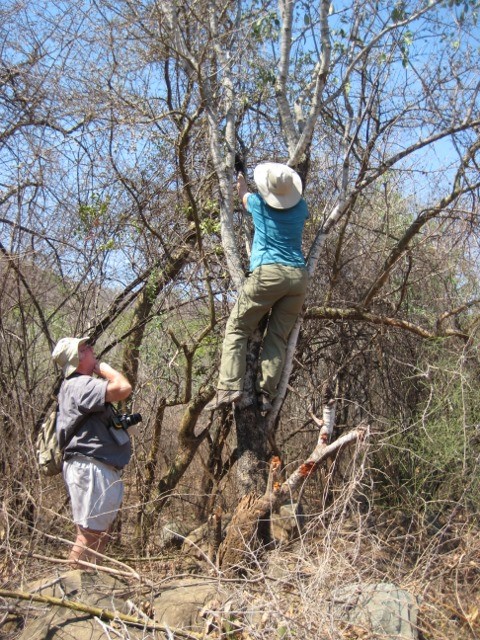
Albizia tanganyicensis (Paperbark Albizia)
A tree with smooth, creamy white, peeling bark attracted our attention and had the more energetic members, led by Mark, scaling up the steep, very rocky slope. The long flat brown pods lying on the ground and the very young bipinnate leaves confirmed that it was an Albizia tanganyicensis (Paperbark Albizia). It was finally agreed that the Strychnos with the light grey smooth bark and round, 4-7cm diameter, bluish green fruit was a Strychnos innocua (Dull-leaf Monkey Orange). The only trees on the hillside which were in full leaf were Dalbergiella nyasae (Mane Pod), Boscia angustifolia (Rough-leaved Shepherd’s Tree) and Xeroderris stuhlmannii (Wing-pod). The former had their very distinctive, oblong, flat, velvety pods with a fringe of dense, long, brown, plumose hairs, completely edging the whole pod and many of the latter had pretty, white pea-shaped flowers. An Acacia with ascending branches, distinct woody cushions and white ball-like flowers had us guessing until we found a few thin sickle-shaped pods confirming it was a Acacia gerrardii (Grey haired Acacia). Next to it and partly hidden in the long grass was a small baobab (Adansonia digitata) It was only just getting its new flush of leaves and the ones we examined were all simple leaves.
Most of our group remained in the cool of the Pod Mahogany while a few of us braved the heat. We managed to identify a small Securidaca longipedunculata, (Violet-tree) Albizia amara (Bitter Albizia) with its long narrow, imparipinnate leaves which are about four times as long as they are wide, and Lannea discolor (Live-long). The L. discolor had just finished flowering and the fleshy, ovoid fruits, tipped with tiny remains of the styles, were just starting to develop. A small, much branched Ozoroa with a dark grey, rough bark and small leaves had us so confused that a specimen was pressed for further verification. The large, 4-winged, pale brown pods of the Combretum zeyheri (Large-fruit Combretum) and the split, hard, woody, paired follicular carpels of the Diplorhynchus condylocarpon (Wild-rubber), were the only “labels” which gave us a clue to their identification.
Along the watercourse, we came across a number of large trees. Kirkia acuminata (Kirkia) was looking splendid in its new leaf and covered with small, cream and white flowers in branched axillary inflorescences. Pterocarpus rotundifolius (Round-leaved Bloodwood) was in bud waiting for the first rain showers (let us hope it doesn’t have to wait too long!), when the beautiful, deep yellow, pea-shaped flowers with crinkly petals open. There will be a gap of a few days before the next batch is ready; this process may be repeated several times before flowering is over. Right on top of the Afzelia quanzensis (Pod-mahogany/ Chamfute) were its erect flowers with a single large, streaked, pinkish red petal. Erica so enjoyed their sweet scent that she kept a handful of them in her pocket for aromatherapy. Philenoptera violacea (Rain-tree), Terminalia sericea (Silver terminalia/ Mangwe) and Azanza garckeana (Snot Apple) were all in full leaf.
Mark was happy to find a few climbers: Adenia digitata with its long stems growing from a large fleshy underground tuber, Opilia amentacea and Jasminum fluminense (River Jasmine). Jasminum fluminense and J. abyssinicum are our only two native species of Jasmine with compound leaves.
By 11.30, the heat was so intense that we decided to drive to the riverine trees where there was some shade. We crossed the dry river bed and on the bank was a Rourea orientalis (Short-pod), a shrub which favours riverine thickets at low altitudes. Large Trichilia emetica, (Natal-mahogany) Kigelia africana (Sausage-tree), Ficus burkei (Common Wild Fig) and Diospyros mespiliformis (African ebony/ Jackal-berry) provided us with the deep, cool shade we had hoped for. The D. mespiliformis had its small, fragrant, bell-shaped, cream-coloured flowers. A diagnostic feature is the stalked bunches of male flowers and the solitary, female flowers which are found on separate trees. There was a lovely specimen of a Lannea schweinfurthii (False-marula) in full flower. The flowers are small, creamy white to yellow, in rather loose, catkin-like spikes up to 12 cm long.
Other trees in flower were the Ziziphus mucronata (Buffalo-thorn), Olax dissitiflora (Small fruit Olax), Bauhinia galpinii (Red Bauhinia) and the climber Dalbergia arbutifolia (Eastern Climbing Dalbergia). The latter also had elliptic-oblong pods tapering to a blunt point, but these were growing so high up that they could only be observed through binoculars. Shrubs growing on the edge of the riverine area were Euclea divinorum (Magic Guarri), Allophylus rubifolius (Lowveld False Rhus) and the climbing Combretum microphyllum (Burning-bush Combretum) which sadly did not have its showy, crimson-red flowers.
On the way home, the wonderful show of white flowers of the Ehretia amoena (Sandpaper Stamperwood) attracted Mark’s attention. The shrub was typically twiggy with somewhat arching branches and next to it was a young Sclerocarya birrea (Marula) with its imparipinnate, spirally arranged leaves and the rachis tinged with pink.
We returned to New Year’s Gift for lunch and a short rest and in the afternoon three members took up Sylvester Hlatshwayo’s kind invitation to show us the route to the top of a hillside. We met at the Coffee Pulpery (Tanganda grows coffee on New Year’s Gift) where there was a large Pterocarpus angolensis (Mukwa, Bloodwood) clothed in new leaf and next to it was a magnificent Terminalia gazensis (Fringed leaf Terminalia) in full flower. The route was very rocky and quite hard going but at the top we were rewarded with the most incredible view of the whole of the New Year’s Gift Estate lying in the valley below. It was alarming to see how the Albizias (A. procera?) which were introduced from Asia to the Eastern Zimbabwean tea estates as shade trees, have escaped and become naturalised along the rivers. At this time of the year they have shed their leaves so the light, creamy coloured bark caused them to stand out very conspicuously.
A tree that we hadn’t seen in the morning when we were at the bottom of the hill was Maerua angolensis (Bead-bean). This specimen was literally dripping with long, green, slender pods, irregularly constricted between the seeds, hence the common name. Growing on all the Lannea discolor (Live-long) was a parasite with beautiful orange flowers. The Ximenia caffra (Sourplum) was just coming out in its new leaf while Mundulea sericea (Cork Bush) could only be identified by its light grey, deeply furrowed, corky bark and the small flat pods covered in velvety hairs.
The three of us joined the rest of the group for a delicious tea at Sue and Jamey Otterson’s home.
I have to express our indebtedness to Mark, Meg and Tom who braved the heat and shared their immense knowledge with us.
-Soo Fawcett
TONY ALEGRIA CHAIRMAN


